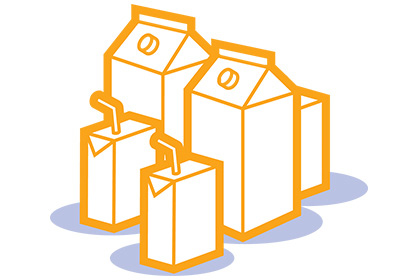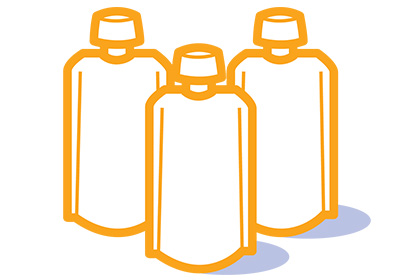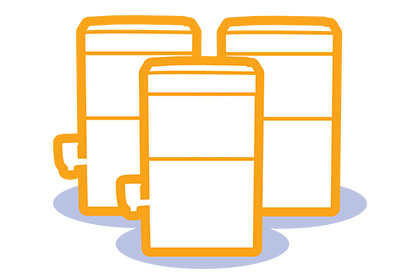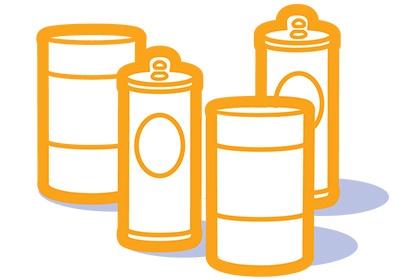5 Environmental Report
- Detailed report on the reduction in greenhouse gas emissions, energy savings and CO2 equivalent reduced from recycling.
- End Fate report for aluminum, plastic, glass, polycoat and other materials.
5.1 Environmental Report
The Government of British Columbia has adopted public policies intended to promote a low-carbon economy. As a stewardship agency operating under a provincial regulation, Encorp compiles applicable data, and analyzes and reports on the impacts of its stewardship activities.
In 2021, Encorp recycled 89,284 metric tonnes of used beverage containers. The energy saved through the recycling of these materials has been converted into tonnes of carbon dioxide equivalent (CO2e), the common measure of greenhouse gas (GHG) emissions, based on the US Environmental Protection Agency’s Waste Reduction Model (WARM). The avoided emissions published in this report were calculated using the WARM version 13 [06/14] (Refer to End Fate table in Section 5.2).
In total, Encorp’s activities in 2021 contributed to the reduction of about 110.2 thousand tonnes of CO2e being released into the atmosphere, compared to 105.5 thousand tonnes in 2020 and 104.8 in 2019 baseline. The higher CO2e reduction is primarily attributed to the increase in the volume of aluminum and plastic containers, which contributes to higher emissions savings by recycling.
While recycling has an overall net benefit in terms of energy and emissions savings, the recycling process itself requires energy and thus has GHG emissions associated with it. When estimating net savings, Encorp calculates the GHG emissions specifically associated with its stewardship activities.
Since Encorp is not a manufacturing company, the majority of its associated GHG emissions come as a result of transporting materials as well as heating and powering its network of facilities. The calculation of GHG emissions is based on the following methodology.
Methodology
As a Climate Smart certified business, Encorp conducted its GHG emissions inventory according to the Greenhouse Gas Protocol Corporate Accounting and Reporting Standard, Revised Edition. The GHG Protocol is an internationally recognized standard published by the World Resources Institute and the World Business Council for Sustainable Development.
Organizational Boundaries
Encorp used the operational control approach to determine its organizational boundary and included in its inventory all operations over which it has operational control. The following facilities were included in Encorp’s inventory:
- Head Office and QA Office
- Processing facilities (13 vendors)
- Depots (174 vendors)
- Commodity shipping to end market recyclers (12 vendors)
The utility activities below were included in Scope 3 because of a lack of operational control, as these facilities are operated by Encorp’s vendors.
Inventory Boundaries
The GHG Protocol requires the inclusion of Scope 1 and 2 emissions, and suggests including Scope 3 emissions from activities relevant to an organization’s business and goals, and for which reliable data can be obtained. Encorp included emissions from the following activities under Scopes 1, 2 and 3:
Scope 1: includes direct GHG emissions from sources that are owned or controlled by the reporting company or organization
- Natural gas for building heat
Scope 2: includes indirect GHG emissions from purchased electricity and purchased heat
- Purchased electricity
Scope 3: includes indirect GHG emissions that are consequences of the reporting company’s operations but occur at sources owned by another company
- Unmetered/unbilled electricity and heat
- Business travel (air, water and road)
- Third-party haulage and shipping
- Paper consumption
Scope 3 emissions from waste were excluded from the inventory because of a lack of available data.
Emissions from waste are likely immaterial compared to Encorp’s total inventory.
Scope 3 emissions from staff commuting were also excluded due to Encorp switching to a hybrid work model. Emissions from staff commuting were likely immaterial in 2021 due to the majority of staff working from home.
Emission Factors
This inventory was conducted using the emissions factors from the Climate Smart web-based greenhouse gas management tool. The Climate Smart GHG management tool was designed for adherence to the GHG Protocol. Climate Smart’s emissions factors come from a variety of sources, such as Environment Canada, the GHG Protocol Initiative, the US Environmental Protection Agency and the Intergovernmental Panel on Climate Change. Climate Smart reviews its emissions factors annually to update them based on refined industry methodology and changing electricity grids.
Scope 1
Scope 1 emissions totalled 46.92 tCO2e in Encorp’s 2021 calendar year, down by 5% since baseline year.
Scope 2
Scope 2 emissions totalled 4.61 tCO2e in Encorp’s 2021 calendar year, up by 95% since baseline year.
Scope 3
Scope 3 emissions totalled 11,235.37 tCO2e in Encorp’s 2021 calendar year, down by 4% since baseline year.
5.2 Container Recycling End Fate Report
All containers collected by Encorp in 2021 were shipped to recyclers for further processing into new material in accordance with Section 8 of the Recycling Regulation.







